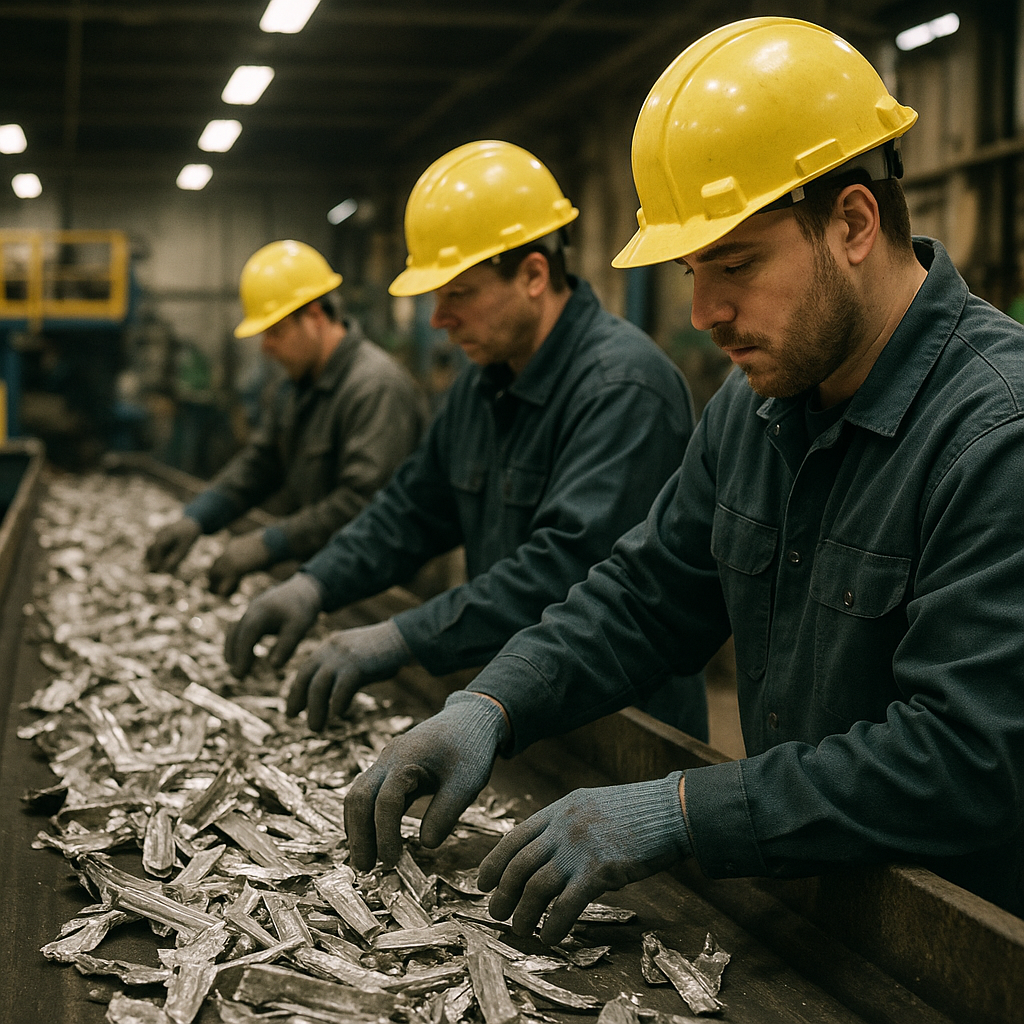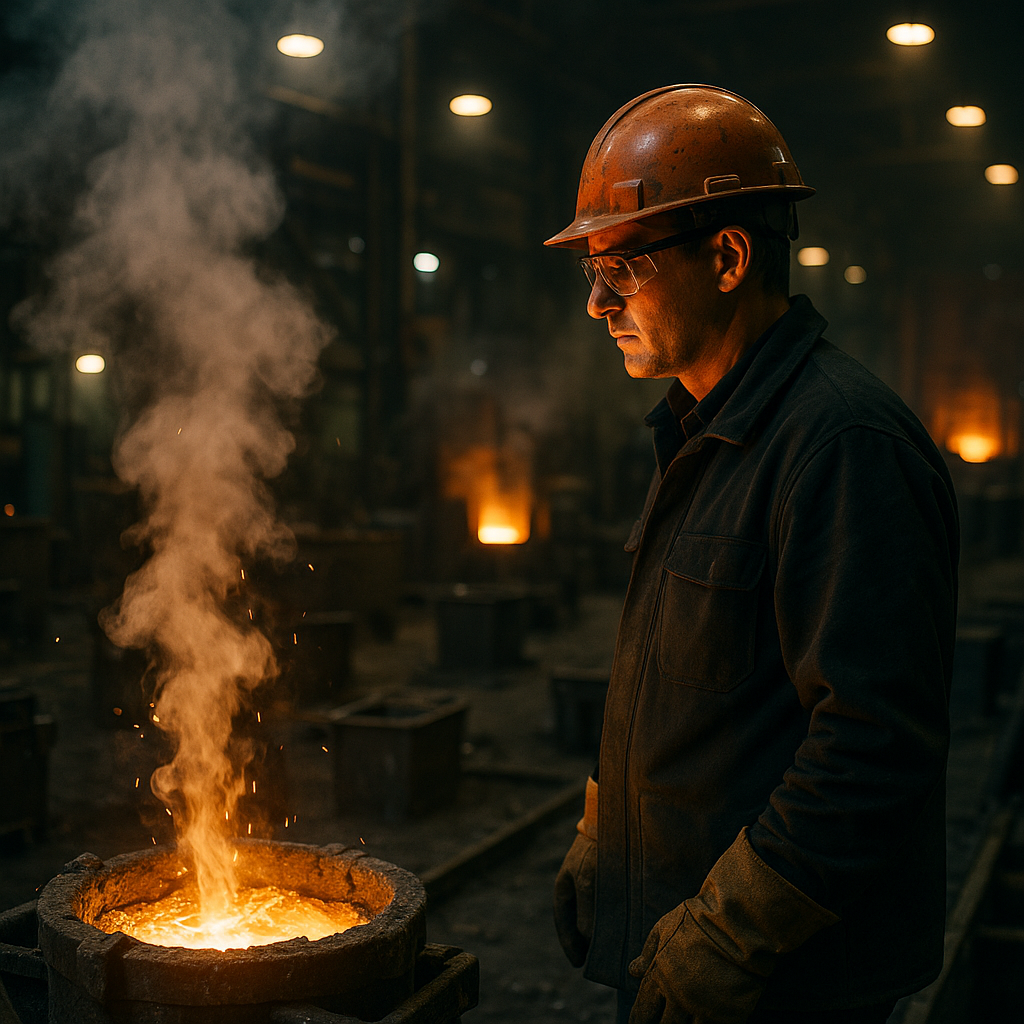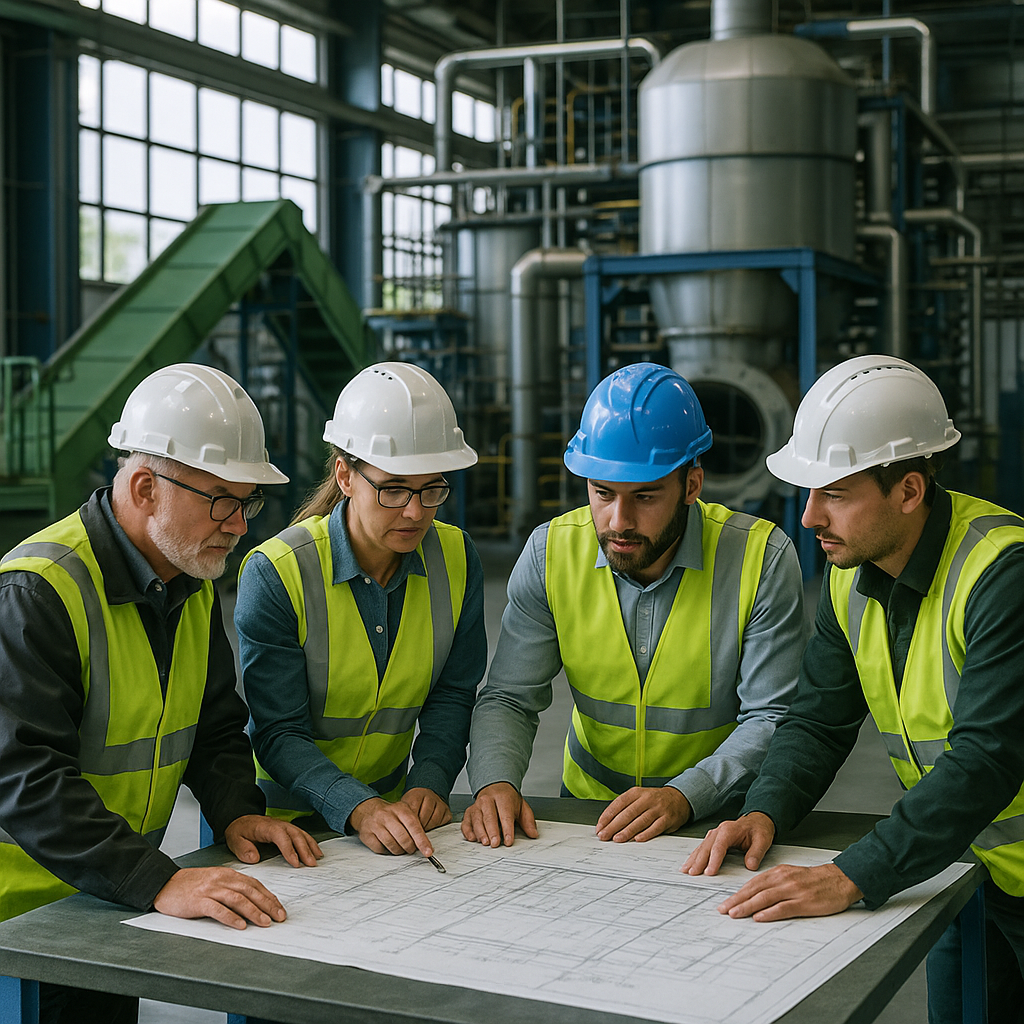5901 Botham Jean Blvd, Dallas, TX 75215
Aluminum Scrap Melting: Process, Furnace Types, Challenges, and Future Trends
October 2, 2025Aluminum scrap melting transforms discarded aluminum items into valuable new metal through a specialized recycling process.
The aluminum scrap melting process involves several key stages. First, various types of scrap—from used beverage cans to automotive parts—are collected and meticulously sorted according to alloy composition. Next, the material undergoes pre-treatment processes, including shredding, decoating, and demagnetizing, to remove contaminants. The prepared scrap is then melted in specialized furnaces where impurities are removed.
Finally, the molten metal is cast into ingots, billets, or directly into semi-finished products, ready for manufacturing. This cycle allows aluminum to be recycled repeatedly without degrading its inherent properties, making it a truly sustainable material in our resource-conscious world.
How is Aluminum Scrap Prepared for Melting?

Preparing aluminum scrap for melting involves several steps to ensure optimal metal recovery and quality in the final product. Each stage in the preparation process is crucial for efficient, cost-effective recycling operations while minimizing environmental impact.
The process typically includes these key steps:
Collection and Sorting
The initial phase involves collecting and sorting scrap based on specific characteristics:
- Source separation: Aluminum is gathered from various sources including manufacturing scrap, used beverage cans, automotive parts, and building materials.
- Alloy identification: Scrap is sorted by alloy type, as different alloys have unique melting points and chemical compositions. This sorting can be performed manually or with advanced technologies like X-ray fluorescence or laser-induced breakdown spectroscopy.
- Purity assessment: Materials are classified by contamination levels, with cleaner scrap requiring fewer processing steps.
Size Reduction
After sorting, the scrap undergoes mechanical processing to reduce its size:
- Shredding: Large pieces are broken into smaller fragments using industrial shredders, making the material easier to handle and melt.
- Crushing: Further reduces particle size and helps separate aluminum from attached materials.
- Granulating: Produces fine particles ideal for efficient melting, increasing surface area and reducing melting time.
Contaminant Removal
Removing impurities is essential for producing high-quality recycled aluminum:
- Decoating: Thermal or chemical processes remove paints, lacquers, and coatings from the aluminum surface. This step improves metal purity and prevents harmful emissions during melting.
- Demagnetizing: Magnetic separators remove ferrous materials like steel that may be attached to the aluminum scrap.
- Eddy current separation: This method uses electromagnetic fields to separate non-ferrous metals from non-metallic materials.
- Dense media separation: Uses fluids of specific gravity to separate materials based on density differences.
Pre-treatment
Final preparation steps ensure the scrap is ready for the furnace:
- Drying: Removes moisture that could cause hazardous reactions in molten metal.
- Baling: Compresses loose materials into dense blocks for more effective handling and melting.
- Briquetting: Compacts fine particles like turnings and chips into solid blocks to reduce oxidation during melting.
These preparation stages significantly enhance the melting process efficiency. Well-prepared scrap requires less energy to melt, produces fewer emissions, generates less dross (surface oxide), and yields higher-quality recycled aluminum.
The thoroughness of scrap preparation directly influences the economic and environmental impact of aluminum recycling. Advanced recycling facilities continually refine these processes to maximize metal recovery while minimizing resource consumption.
What Types of Furnaces are Used for Melting Aluminum Scrap?
The selection of furnace technology is crucial in aluminum recycling operations. Different furnace types handle varying qualities of scrap material, each offering specific advantages based on production needs, energy costs, and desired metal quality.
Reverberatory Furnaces
Reverberatory furnaces are the most widely used technology for melting aluminum scrap in large-scale operations. Featuring wall-mounted burners, these furnaces direct heat toward a stationary hearth where the aluminum melts. Heat transfer occurs primarily through radiation from the refractory brick walls, supported by convective heat from the burner.
These furnaces handle capacities up to 150 tons of molten aluminum, making them ideal for high-volume processing. They operate with thermal efficiencies between 15-39%, which can improve to 50-55% with recuperation systems that preheat combustion air. Despite low operating and maintenance costs, reverberatory furnaces tend to produce higher metal oxidation rates than other technologies.
Rotary Furnaces
Rotary furnaces consist of cylindrical steel drums lined with refractory material, mainly used for processing low-grade aluminum scrap and dross with significant contamination. The rotating action enhances heat transfer through direct contact between the charge and heated refractory walls.
With typical capacities of 2 to 5 tons, these furnaces often use salt flux to improve metal recovery and reduce oxidation. Their main advantage is processing materials that other furnace types cannot handle efficiently. However, they have drawbacks, including lower energy efficiency, higher maintenance, and the production of salt cake waste that requires special handling.
Electric Induction Furnaces
Induction furnaces use electromagnetic fields to generate heat directly within the metal. This technology creates eddy currents in the aluminum, rapidly heating and melting it without direct flame contact. Induction furnaces range in size from very small to approximately 7.5 tons.
The key advantages include excellent energy efficiency (over 90% in some cases), precise temperature control, and minimal contamination of the aluminum. These furnaces also produce lower emissions and reduce metal loss to around 1%. Main disadvantages are higher initial investment costs and limitations on processing heavily contaminated scrap.
The stirring motion created by the electromagnetic field helps minimize temperature gradients within the melt, improving consistency. This technology is especially suitable for high-quality applications where metal purity is critical.
Other Furnace Technologies
Several specialized furnace types serve specific purposes in aluminum recycling:
Tower furnaces feature vertical designs where aluminum is charged from the top and melts as it descends. They achieve high efficiency (40-77%) and low oxidation losses but are limited by height requirements and higher capital costs.
Crucible furnaces, available in gas-fired and electric varieties, are typically used for small batches or operations requiring frequent alloy changes. Offering flexibility and low oxidation rates, they have limited capacity and generally lower efficiency.
Electric reverberatory furnaces use resistance heating elements mounted in the furnace roof. Rarely used as primary melters, they excel as holding furnaces where emissions control and product quality are priorities.
Impact of Furnace Selection on Recycling Operations
The choice of melting technology fundamentally shapes recycling economics and environmental impact. Furnace selection must consider the quality of scrap, production volume needs, energy costs, and final product specifications.
For heavily contaminated scrap, rotary furnaces often provide the only viable solution despite their lower efficiency. Cleaner scrap can be processed in more efficient reverberatory or induction furnaces, yielding higher metal output and reduced environmental footprint.
Energy considerations vary significantly across technologies. While gas-fired reverberatory furnaces consume 1,300-2,500 Btu/lb of aluminum, electric induction furnaces require 450-550 kWh per ton but achieve higher energy efficiency overall.
Ultimately, selecting furnace technology represents a critical balance between operational flexibility, energy consumption, metal yield, and environmental performance in aluminum recycling operations.
| Furnace Type | Advantages | Shortcomings |
| Reverberatory Furnace | Large capacity, handles diverse scrap types, low operating costs | High energy use, lower metal recovery, high emissions |
| Rotary Furnace | Efficient with low-grade scrap, better heat transfer | Low energy efficiency, high maintenance, salt cake waste |
| Induction Furnace | High efficiency, precise control, low emissions | High initial cost, limited by scrap quality |
| Gas-fired Furnace | High energy efficiency, stable operating cost | Slow heating, requires regular cleaning |
What are the Challenges in Aluminum Scrap Melting?

Aluminum scrap melting faces multiple technical hurdles that recycling facilities must overcome to produce high-quality secondary aluminum. The primary challenge is managing impurities that enter the process through various scrap streams. Unlike primary production, where raw material purity is precisely controlled, recycled aluminum contains a complex mix of elements that can compromise the final product quality.
Controlling the chemical composition is perhaps the most fundamental challenge in aluminum recycling. Scrap originates from diverse alloy families with different alloying elements in varying concentrations. This diversity makes it difficult to control impurity levels and achieve target alloy compositions. Iron contamination is particularly problematic because it cannot be easily removed from molten metal and forms brittle intermetallic compounds that reduce mechanical properties.
Coatings and surface treatments present another significant obstacle. Many aluminum products contain paints, lacquers, and other protective finishes that introduce unwanted elements into the melt. For instance, titanium dioxide (TiO2), a common white pigment, reacts with molten aluminum to form aluminum oxide dross and can introduce titanium into the melt. At concentrations above 0.15%, titanium can form brittle AlTiSi intermetallic compounds that compromise product integrity.
Metal loss during processing remains a persistent issue. When aluminum is exposed to oxygen at high temperatures, it rapidly forms aluminum oxide (Al2O3). This oxide layer, known as dross, represents a direct loss of recoverable metal. Fossil-fuel furnaces typically experience 5-8% metal loss, while electric furnaces perform slightly better with 0.5-3% loss. This difference significantly impacts both economic viability and resource efficiency.
Sorting and Pre-treatment Challenges
Efficient sorting of incoming scrap material poses both technical and economic challenges. Technologies like X-ray fluorescence (XRF), laser-induced breakdown spectroscopy (LIBS), and eddy current separation can differentiate between alloy types but require significant investment. Traditional density-based separation methods can help isolate aluminum from other materials but struggle to distinguish between different aluminum alloys.
Pre-treatment processes like decoating aim to remove paints, plastics, and oils from scrap before melting. Thermal decoating can effectively remove organic compounds but fails to eliminate inorganic materials such as pigments and fillers. Chemical decoating achieves better results but involves more complex processes and introduces environmental considerations.
Alloy mixing further complicates recycling efforts. When scrap from different alloy families is melted together, the resulting composition may not meet specifications for high-value applications. Currently, recyclers address this by diluting with primary aluminum or downgrading to alloys with higher tolerance for impurities. Both approaches reduce the sustainability benefits of recycling.
Furnace Selection and Operation
Choosing the right melting technology significantly impacts both quality outcomes and energy efficiency. Reverberatory furnaces offer high-volume processing with simpler operation but suffer from lower energy efficiency (15-39%) and higher oxidation rates. Rotary furnaces achieve better efficiency but require more complex maintenance and operation. The initial scrap quality often dictates which technology is viable.
Salt flux management presents additional challenges. Fluxes based on sodium and potassium chlorides help protect molten metal from oxidation and improve the recovery of aluminum from dross. However, the resulting salt slag is classified as hazardous waste in most European countries, requiring specialized treatment and recovery processes.
Meeting increasing quality demands with variable input materials remains perhaps the greatest overall challenge. As end-use applications require tighter specifications, recyclers must find ways to produce consistent high-quality alloys from increasingly diverse scrap sources. Without effective solutions, the growing surplus of difficult-to-recycle scrap threatens to undermine aluminum’s status as an infinitely recyclable material.
Conclusion: The Future of Aluminum Scrap Melting

The future of aluminum recycling is being shaped by technological advancements that enhance recovery rates and material quality. Advanced sorting technologies, such as Laser Induced Breakdown Spectroscopy (LIBS) and AI-driven systems like TOMRA’s GAINnext, are achieving unprecedented purity levels in aluminum scrap processing.
Meanwhile, innovations in melting furnace technology—particularly electromagnetic stirring systems, which can boost productivity by 25% while reducing energy consumption by 10%—are making the process more efficient than ever. These innovations are crucial as the global aluminum recycling market is projected to reach $25.12 billion by 2030, growing at a CAGR of 8.16%.
The path forward requires continuous innovation and collaboration across the industry. For sustainable growth, the focus must shift to developing low-fluoride flux formulations, optimizing processing techniques, and building more efficient closed-loop recycling systems. As demand for aluminum increases—projected to grow 15% by 2029—efficient recycling will be essential to meet this need while minimizing environmental impact.
For your recycling needs and to learn more about implementing sustainable recycling solutions, contact Okon Recycling at 214-717-4083.
